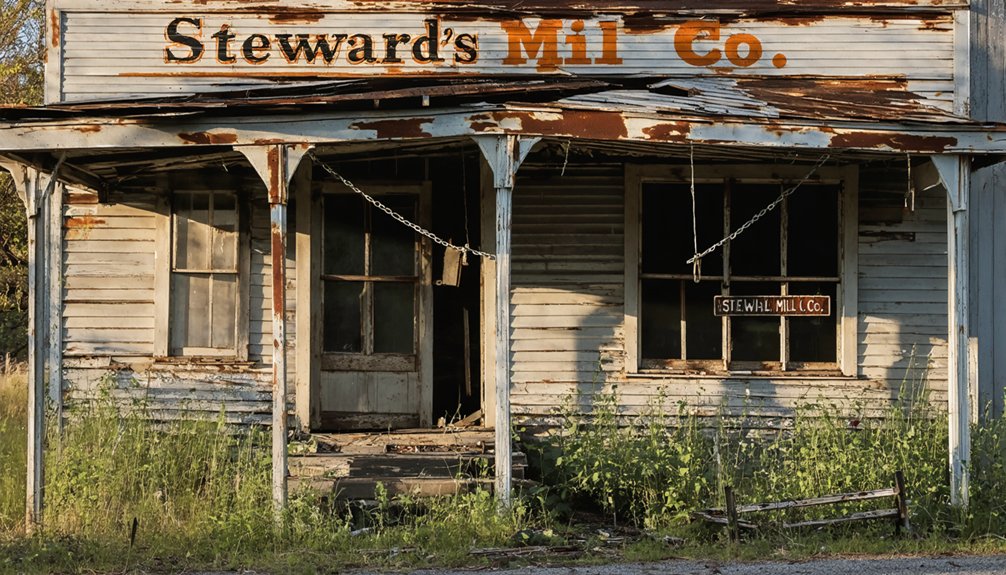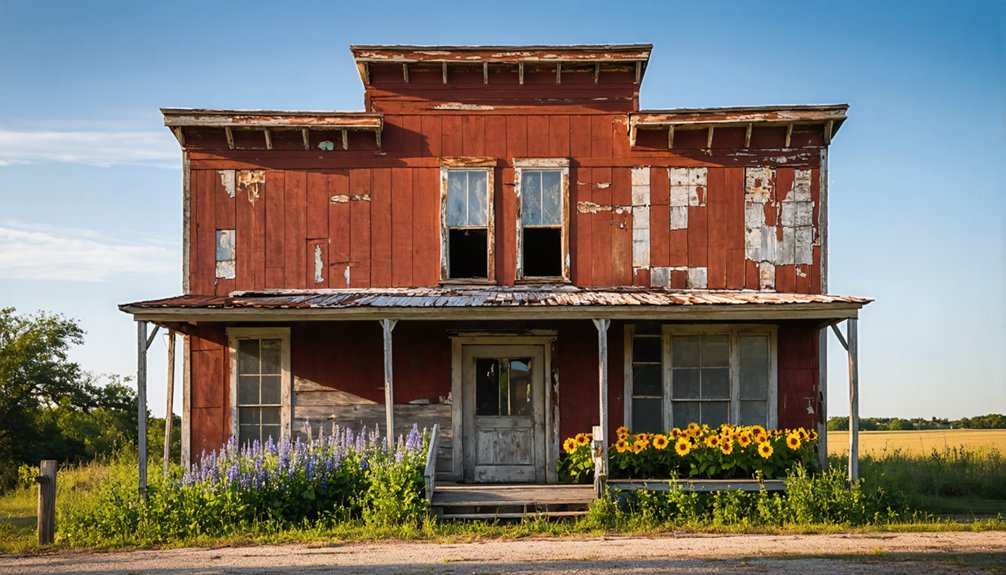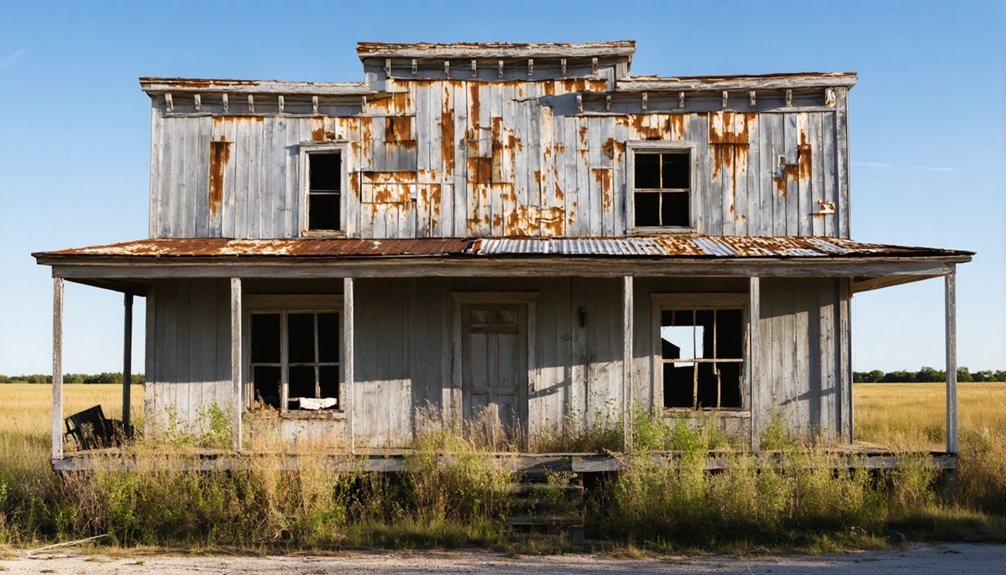You’ll find Steward’s Mill, a historic ghost town, seven miles north of Fairfield, Texas, at the intersection of Farm Roads 833 and 2547. Washington Steward founded the settlement in 1849 with a water-powered gristmill, and by 1880, the town boasted 70 residents, a general store, post office, and the county’s first telephone exchange. After a devastating mill fire in 1935 and economic decline, the site now preserves its frontier legacy through historic structures like the 1876 wooden church and Dr. Bonner’s store.
Key Takeaways
- Founded in 1849 around a water-powered gristmill, Steward’s Mill declined from 70 residents in 1880 to near abandonment by mid-1900s.
- A devastating mill fire in 1935, post office closure in 1914, and timber depletion led to the town’s transformation into a ghost town.
- Historical structures remain, including an 1876 wooden church and Dr. Bonner’s general store, which received historical recognition in 1964.
- Located at Farm Roads 833 and 2547 intersection, seven miles north of Fairfield, the site allows free exploration of remaining structures.
- The town’s decline mirrors many Texas frontier communities, preserving its legacy through remaining buildings and historical documentation.
The Rise of a Texas Mill Town
In 1849, Washington Steward’s construction of a water-powered gristmill on Mill Creek marked the beginning of Steward’s Mill, Texas. As one of the few mills in the region, it drew farmers from Ellis and Dallas counties seeking to process their wheat and corn crops, establishing the settlement’s historical significance in regional agriculture.
You’ll find the community development accelerated after Dr. James I. Bonner opened the first general store in 1867. By 1872, the town gained its own post office, and within four years, residents constructed a shared church building that served multiple denominations. The wooden church structure remains standing today as a testament to the town’s heritage.
The town’s growth peaked in 1880 with 70 residents, boasting the county’s first telephone exchange. Supporting industries emerged, including a brick plant and sawmill, while the area became renowned for its mule breeding operations. Today, the once-bustling town has dwindled to just five mailboxes along the roadside.
Early Settlers and Community Founders
Pioneers from South Carolina laid the foundation for Steward’s Mill when Washington Steward established the area’s first gristmill in 1849.
You’ll find the founding families‘ roots extend back to 1826, with settlers from the H. Awalt and J. James land surveys predating Steward’s arrival.
The community dynamics evolved quickly as Dr. James Isaac Bonner opened the first general store in 1867, creating a crucial hub that would serve residents for over a century.
Washington’s son, Jeremiah T. Steward, became a pivotal figure when he took the role of postmaster in 1872.
Early settlers, many traveling from Mississippi, chose this location for its abundant water and timber resources.
The rich natural resources of water and timber drew early pioneers from Mississippi to establish their new homes here.
Together, these pioneering families built a thriving community centered around agriculture, commerce, and shared values.
Life Around the Gristmill
While Washington Steward’s gristmill served as the beating heart of the community from 1849 onwards, life around the mill blossomed into a vibrant social and economic hub.
You’d find farmers traveling from Ellis and Dallas counties to grind their wheat and corn, while local businesses like Dr. Bonner’s general store thrived nearby. Just like R.H. Stewart who ran Oriental Mine operations in Nevada, local industry leaders shaped the community’s development. Like the town of Bartonsite in 1907, the area saw rapid growth as structures and businesses emerged around its economic center.
Community gatherings shaped the social traditions, with folks rising at 4 a.m. for breakfast excursions to Anglin Spring or joining baseball games and horse races.
During picnics, you might’ve spotted creative adaptations like makeshift bathes from chicken wire and towels when it rained.
The mill’s presence sparked growth in other industries too, including a brick plant and sawmill, while mule breeding attracted traders from as far as Tennessee.
Agricultural Legacy and Impact
Established around 1849, Steward’s Mill quickly grew into a thriving agricultural powerhouse centered on Washington Steward’s water-powered gristmill. This hub of agricultural innovation transformed the region’s farming capabilities, drawing farmers from Ellis and Dallas counties to process their wheat and corn.
You’ll find the town’s agricultural legacy shaped by:
- Cotton and corn production, with remarkable yields reaching 98 bales of cotton and 900 bushels of corn by 1860
- A robust mule breeding industry attracting buyers from as far as Tennessee
- Essential infrastructure including a brick plant, sawmill, and the county’s first phone exchange
- A close-knit community of farming families bound by shared resources and religious institutions
The Stewards Mill Store, built in 1867 by Dr. James I. Bonner, served as a vital commercial center for the farming community. The area’s prosperity was exemplified by prominent landowner John Bonner, who acquired extensive tracts between 1854 and 1858. This community resilience, built on agricultural progress, sustained the town’s population through the late 19th century, though it eventually declined to 55 residents by 1947.
Geographic Features and Location
You’ll find Steward’s Mill Ghost Town at the crossroads of Farm roads 833 and 2547, seven miles north of Fairfield in north-central Freestone County.
The town’s location features rolling hills and fertile plains characteristic of North Central Texas, with a small stream that once powered the community’s gristmill.
The intersection of these well-maintained farm roads makes the site accessible by two-wheel-drive vehicles, allowing you to explore the remaining historical structures and surrounding rural landscapes. The original settlement began when Washington Steward constructed a water-powered gristmill in 1849.
Regional Landscape Features
Situated between Dallas and Houston in Freestone County, Steward’s Mill occupies a characteristic stretch of Texas Blackland Prairie marked by gently rolling terrain and rich, dark soils.
The geological formation of the area features elevations between 300-600 feet above sea level, creating an ideal landscape for farming due to its exceptional soil fertility. Like Valentine, Texas, the region faces challenges with soil erosion issues that affect property development and agricultural activities. The area’s proximity to Cedar Creek connects it to the historic Donie region of Freestone County.
You’ll find these distinct features in the region:
- Native tallgrass prairies interspersed with post oak and hardwood forests
- Small creeks winding through the gently undulating terrain
- Dark, productive soils that once supported extensive cotton cultivation
- A mix of open prairie and woodland patches reflecting the original ecosystem
The area’s natural water resources originally supported a water-powered gristmill, though today the landscape has largely returned to its rural character with scattered residential properties.
Transportation Routes Intersection
The rural roads threading through Steward’s Mill’s prairie landscape converge at the junction of Farm Roads 833 and 2547, forming a significant intersection approximately 7 miles north of Fairfield in north-central Freestone County.
You’ll find these two-wheel drive accessible roads following historic property lines from the 1826 H. Awalt and J. James surveys, showcasing the area’s transportation evolution from early settlement paths to established farm routes.
The intersection’s rural connectivity played a crucial role in the community’s development, enabling the transport of agricultural products to larger markets and supporting the area’s first telephone exchange.
While the post office closed in 1914, the crossroads continue to serve local farmers, connecting them to surrounding communities and maintaining the legacy of this once-thriving mill town.
Daily Life in Steward’s Mill
Life in Steward’s Mill centered around a vibrant mix of agricultural work and community gatherings.
You’d find yourself spending days working at the grist mill, where farmers brought their wheat and corn for processing, or tending to cotton fields and livestock. Local cuisine often featured fresh-picked blackberries during community picnics and outdoor breakfast gatherings.
Your social calendar would include:
- Horse races that drew participants from across the region
- Baseball games that united neighbors of all ages
- Ring plays and parties for evening entertainment
- Family fishing trips and outdoor activities
You’d conduct your daily business at Dr. Bonner’s general store, communicate through the county’s first phone exchange, and pick up mail at the post office that served the community until 1914.
From Prosperity to Abandonment

You’ll find that Steward’s Mill‘s journey from prosperity to decline traces a clear arc, starting with its 1850s founding and peaking around 1880 with 70 residents, thriving agriculture, and diverse industries.
The town’s economic importance began eroding in the early 1900s, marked by the 1914 post office closure and the 1930s abandonment of the sawmill due to timber depletion. This pattern of decline mirrors communities like Elmina, Texas, where the lumber supply depletion forced dramatic changes in local industry and population.
Rise and Fall Timeline
Founded in 1849 by Washington Steward’s construction of a water-powered gristmill, Steward’s Mill emerged as a promising agricultural hub in Texas. The community dynamics evolved around essential services, with Dr. James Bonner’s general store opening in 1867 and the first multi-denominational church arriving in 1876.
The historical significance of this settlement was marked by several key developments:
- 1872: Post office established, cementing the town’s regional importance
- 1885: Cotton gin operations began, diversifying the local economy
- 1891: School founded, serving 25 students by 1893
- 1935: Devastating mill fire marks beginning of decline
Economic Impact Assessment
During its peak economic years between 1870 and 1910, Steward’s Mill thrived as a diversified agricultural hub, powered by its water-driven gristmill and expanding cotton operations.
You’ll find that the town’s economic resilience stemmed from its innovative mix of industries, including cotton gins, a brick plant, and renowned mule breeding operations that attracted buyers from Tennessee.
The town’s agricultural innovation wasn’t enough to prevent its decline, though.
Despite having the county’s first phone exchange and Dr. Bonner’s century-old general store, Steward’s Mill couldn’t sustain its prosperity.
The population dropped from 70 residents in 1880 to just 55 by 1947.
The closure of the post office in 1914 marked the beginning of a steady economic downturn, leading to the ghost town you’ll see today.
Historical Preservation Efforts
Despite its dwindling population, Steward’s Mill maintains significant historical structures through various preservation initiatives led by Preservation Texas.
You’ll find the town’s preservation efforts focus on protecting key sites while facing ongoing challenges with limited local resources.
Key preservation highlights include:
- The Steward’s Mill Store earned the first Texas State Historical Survey Committee Medallion given to a store in 1964
- The wooden church from 1876 stands as proof of the community’s religious diversity
- Archaeological guidelines guarantee permanent site stewardship
- Community engagement through oral histories and family accounts safeguard cultural heritage
Despite preservation challenges like a population drop from 70 in 1880 to just six residents today, you’ll see active protection of the mill foundations, store, church, and cemetery dating back to the 1860s continues through organizational support.
Texas Heritage Recognition

When you visit Steward’s Mill today, you’ll notice the 1964 Historical Medallion Award plaque that recognizes the site’s significance in Freestone County’s development.
The town’s architectural preservation status helps protect remaining structures, including the original mill foundations and several pioneer-era buildings.
Local heritage groups continue documenting the mill town’s history through photographs, oral histories, and artifact collections that tell the story of this once-thriving community.
Historical Medallion Award 1964
The Texas State Historical Survey Committee bestowed its prestigious medallion award upon Stewards Mill Store in 1964, marking the first retail establishment to receive this honor in Texas.
This bronze medallion significance extended beyond mere recognition, representing the state’s commitment to heritage preservation and acknowledging the store’s essential role in Texas history since 1867.
- Built by Dr. James I. Bonner and Jeremiah T. Steward using Trinity River lumber
- Served as a significant business and social center for the community
- Hosted local events including horse races, baseball games, and picnics
- Maintained continuous family ownership through multiple generations
You’ll find this historical recognition helped establish precedent for protecting commercial landmarks, proving that Texas values its rural heritage and the independent spirit of its early merchants.
The medallion continues to stand as a symbol of the store’s enduring legacy in Texas culture.
Mill’s Architectural Preservation Status
Since receiving its historic medallion in 1964, Stewards Mill Store has qualified for additional preservation recognition under Texas’s architectural heritage programs.
You’ll find the 1867 structure meets key criteria for landmark status, including its architectural significance as a 19th-century commercial building constructed with locally-sourced lumber from the Trinity River region.
The store’s preservation challenges are being addressed through various state initiatives. You can access Texas Preservation Trust Fund grants ranging from $20,000 to $30,000 for structural repairs and maintenance.
The Texas Historical Commission, along with TASN volunteers, provides frameworks for ongoing preservation efforts. The site’s authentic materials and documented construction costs of $538.20, plus 1876 additions totaling $188.00, help qualify it for historic tax exemptions that support its continued preservation.
Local Heritage Documentation Efforts
Throughout its documented history, Steward’s Mill has garnered recognition from multiple Texas heritage organizations, starting with the Texas State Historical Survey Committee’s medallion award.
Despite facing significant preservation challenges, local historians and descendants of early settlers have worked to document the town’s legacy.
Key aspects of heritage documentation include:
- Anna Wells Watson’s first-hand accounts of early settler experiences
- Records of agricultural activities, particularly cotton farming and mule trading
- Documentation of community infrastructure, including the 1876 churches and 1891 school
- Historical records of the post office’s operation from 1872 to 1914
While the physical town has largely disappeared, you’ll find its story preserved through historical records, remaining structures, and the dedication of those who maintain its memory as a reflection of Texas frontier life.
Exploring the Ghost Town Today
Located at the intersection of Farm Roads 833 and 2547 in north-central Freestone County, Steward’s Mill stands as a quiet reminder of Texas’ rural past.
Your ghost town exploration will reveal several historic structures, including an 1876 wooden church that once served three denominations and Dr. Bonner’s former general store.
Step into history as you discover an 1876 church shared by three faiths and the remnants of Dr. Bonner’s mercantile legacy.
You’ll find the site most accessible by two-wheel drive vehicle, though you’ll want to time your visit during winter, spring, or fall to avoid the intense summer heat.
While there’s no formal tourism infrastructure, you can explore the remaining buildings and glimpse the historical significance of this once-thriving community.
The few occupied residences and abandoned structures tell the story of a town that once boasted a gristmill, cotton gin, sawmill, and brick plant.
Frequently Asked Questions
What Happened to Washington Steward After the Mill’s Decline?
You won’t find direct records of Washington Steward after the mill’s decline, but his legacy lived through his descendants who maintained operations, while the mill’s impact shaped the community’s development until 1955.
Were There Any Major Floods or Disasters That Damaged the Mill?
You’ll find limited records of flood history or disaster impact at this specific mill, though Texas Hill Country’s extensive flooding patterns likely affected its operations along with other regional mills.
What Types of Grain Were Most Commonly Processed at the Mill?
You’d find corn was the dominant grain processed through corn milling at the facility, while wheat was secondary but still important for flour production serving the region’s agricultural families.
Did Native American Tribes Interact With the Steward’s Mill Community?
You’ll find evidence of Native American presence near the mill, with documented interactions between settlers and Caddoan, Kichai, and Tawakoni tribes, though cultural exchange was limited by growing settler expansion.
What Was the Peak Population of Steward’s Mill During Its Heyday?
Like many frontier mill towns that drew farming families, your historic records show Steward’s Mill reached its peak population of 70 residents in 1880, during the height of mill operations.
References
- https://www.youtube.com/watch?v=62bXwytN_XY
- https://www.ghosttowns.com/states/tx/stewardsmill.html
- https://en.wikipedia.org/wiki/List_of_ghost_towns_in_Texas
- https://texashistory.unt.edu/ark:/67531/metapth61101/m1/171/
- http://files.usgwarchives.net/tx/freestone/history/town/stemill.txt
- http://www.usgwarchives.net/tx/freestone/history/town/places.htm
- https://www.texasescapes.com/CentralTexasTownsNorth/Stewards-Mill-Texas.htm
- https://www.youtube.com/watch?v=LSAbt5hHcRI
- https://discovertexasoutdoors.com/places/stewards-mill-texas-a-19th-century-farming-community-frozen-in-time/
- http://linda_walker999.tripod.com/steward-mill.html



